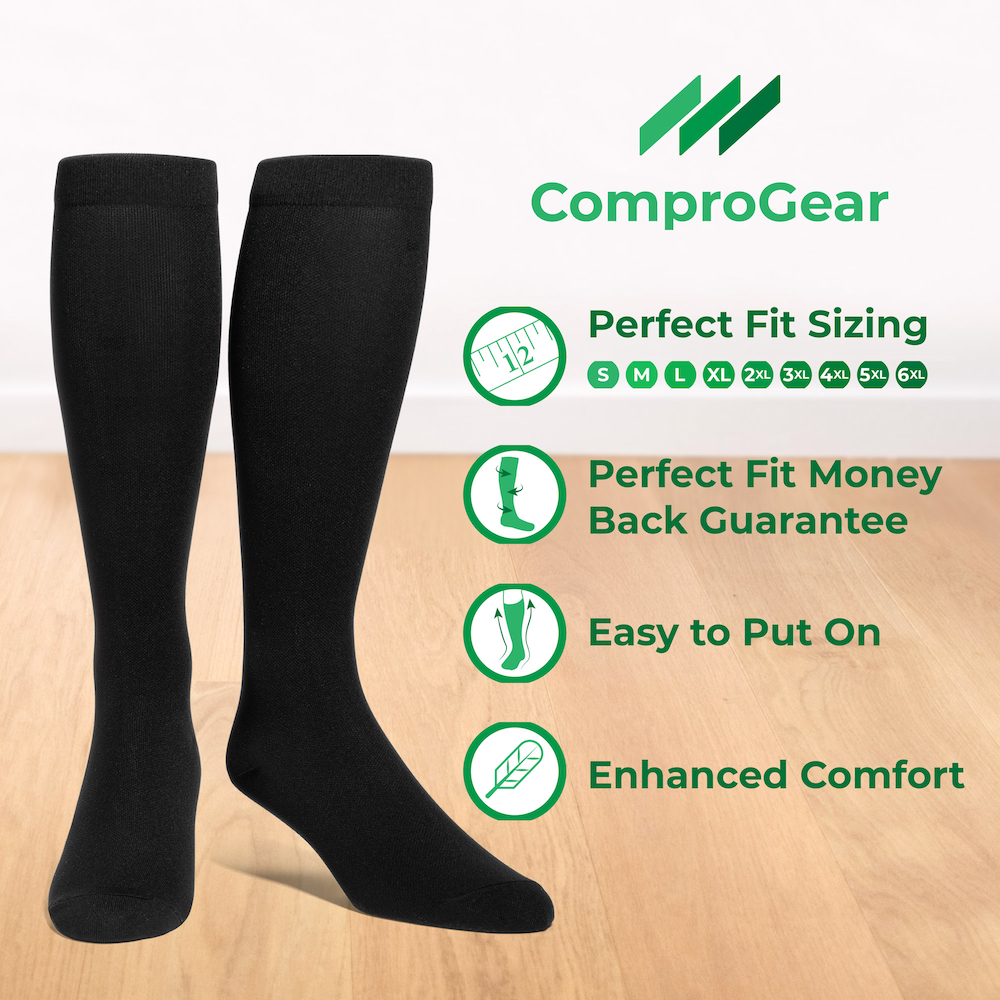
Today we take a look at one of the newest products to have caused a stir in the world of leg and foot pain: Doc Socks. In this Doc Socks Review, we will take a peek into what they are and what they do (and also what they don’t do!). Particularly, we will take a look at the “One-Size-Fits-All” claim and compare that to other compression socks.
Doc Socks have created such a buzz that we wanted to provide a well-researched review so that you can make an informed decision about what types of compressions socks are best.
So keep on reading to find out the truth about the socks.
What are Compression Doc Socks?
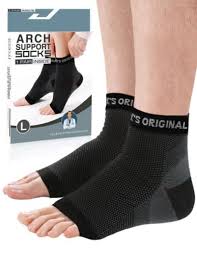
Doc Socks use the term “compression socks” to describe themselves, but that simply begs the question: “what are compression socks?”
The concept of using compression to reduce pain and promote health in the legs and feet has been around for hundreds of years. Compression socks have been medically proven to improve blood flow, reduce pain and swelling in the legs, and prevent serious medical issues such as varicose veins or blood clots.
Doc Socks are a brand of “compression socks” that uses a stretchy material with the intention of creating compression, but with claims that one size of these socks will fit any size person. The Doc Socks company claims to use seven points of compression so as to increase blood circulation but, unfortunately, there doesn’t seem to be any documentation of medical research or doctor approval to back up this claim.
Doc Socks’ “One-Size-Fits-All” branding message means that they make one size of socks regardless of who the user of the compression socks will be. From a small child to a fully grown adult, not considering the leg length, foot size and amount of compression therapy needed, Doc Socks claims that they will provide perfect results every time.
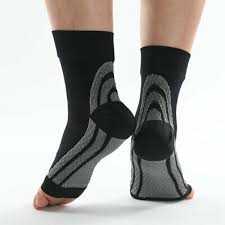
Despite this, the company still claims that their socks work better than competitors’ socks at providing compression therapy.
So we are here to ask some questions and give a review about whether Doc Socks are the real deal. (Hint: we don’t feel good about them so far….)
But before we jump into Doc Socks specifically, let’s take a look at compression technology and compression socks to see what they do, how they work and other specific details about them.
How Do These Socks Work?
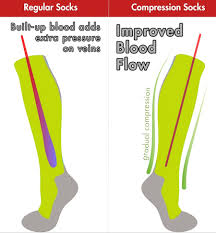
Compression socks are basically what they sound like: socks that compress. Women might have a better understanding of the feeling of wearing this type of material because they feel sort of like wearing tights. While ordinary socks are worn simply for warmth and comfort on the feet, compression socks are made of tight elastic and designed to fit snugly around the ankles and legs. They are tighter around the ankle and not quite as tight around the calves.
The pressure created by the tightness of the socks helps to push the body’s natural fluids up the leg, allowing for better blood flow from the heart. Compression socks not only have the power to improve blood flow, but they can also reduce pain and swelling related to various health conditions or injuries. In addition, doctors recommend compression socks for people who are at risk for DVT (Deep Vein Thrombosis) because the pressure on the legs stops the blood from pooling and turning into blood clots.
What Science Says About Pressure Socks – Claims and Benefits
Compression stockings can keep your legs from getting tired and achy. They can also ease swelling in your feet and ankles, as well as helping to prevent and treat spider and varicose veins. They may even stop you from feeling light-headed or dizzy when you stand up. Because the blood keeps moving, it’s harder for it to pool in your veins and make a clot.
It might be hard to believe that a pair of socks can help with blood circulation and give support to the legs, but science says a lot about the effectiveness of compression socks. Doctors prescribe these socks to patients with serious medical conditions as well as those recovering from surgery, and they can also be used by athletes to prevent injury and/or improve performance.
Types of Pressure Hose Technology
Three main compression techniques are used in compression socks and other compression clothing, including:
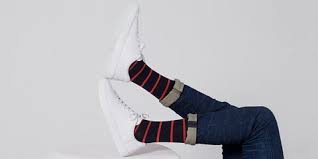
- Graduated compression socks
- Non-medical support socks
- Anti-embolism socks (T.E.D. Socks)
Graduated Pressure Socks
Graduated compression socks offer a compression level that is strongest at the ankle and the pressure gradually decreases toward the top of the socks. These are designed for improved circulation and mobility. They generally require professional fitting because they need to be specifically tailored to the individual. They come in different sizes and compression strengths in order to meet unique needs.
This type of compression socks that ends below the knee helps to limit peripheral edema (leg swelling) as a result of fluid buildup. Some variants may even extend to the thigh or waist to reduce the pooling of blood in the legs, thus preventing orthostatic hypotension. Some graduated compression socks suppliers offer product varieties to meet personal preferences such as open or closed-toe and color options.
Non-Medical Support Stocking
These socks do not necessarily require a prescription. They include flight socks and elastic support as a potential relief for aching legs. You can purchase these socks online or your local pharmacy.
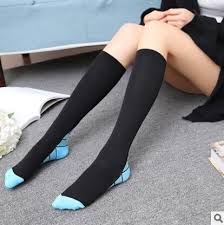
T.E.D Socks
This type of socks aids in reducing the possibility of deep vein thrombosis (DVT). Just like the graduated socks, they offer gradient compression but the level of compression differs. These types of socks are designed for those who are immobile. For those who are bedridden, a T.E.D. sock will assist in preventing pooling of blood in the legs while speeding up recovery even when a person is not able to exercise.
A variety of other medical and comfort products also use the compression therapeutic technique. These products may include socks, sleeves, pantyhose, and stockings.
Who Should Put On Pressure Socks?

Compression socks can be worn by various people–men or women of all shapes and sizes. However, these socks have been designed specifically to benefit people who put a lot of stress on their feet and legs or those who have medical problems that keep them from functioning properly. Athletes may also take advantage of compression socks to improve their performance, promote healing from injuries and reduce pain.
Wearing compression socks provides comfort by reducing pain and stress in the lower extremities, but is important to wear compression socks that are the right size and strength. To get the right compression socks, retailers provide measurement charts so that you can get the right size. However, make sure to check with your doctor on which one to buy (we’ll discuss pressure measurement just ahead).

The pressure applied to the ankles and legs coupled with activities (such as walking) will help to improve blood circulation through the legs. If you wear the wrong size sock, you simply will not get the benefits that you would otherwise.
If your socks are too large, you won’t receive the compression benefits at all and it will be a waste fo your money. Wearing socks that are too tight could place you at risk of numbness, potentially cutting off circulation to the legs and feet. This is why it is so important to wear the right size compression sock.
Compression Socks Vs. Doc Socks
Compression socks are made by different manufacturers, in various shapes, sizes, lengths, and even colors or patterns! Gone are the days of those icky, white, pharamacy-issue knee socks.
Now we’ll take a look at how other compression socks differ from the new-fangled Doc Socks.
Doc Socks are supposedly “One-Size-Fits-All” compression socks and the manufacturers of this product claim they prevent a number of medical conditions such as plantar fasciitis, edema and reduction of pain for those who use them regularly.
Popular Articles on ComproGear
What Level of Compression Socks Do I Need? Compression Socks Sizing mmHg
What Are Pressure Hoses?
Compression socks are medical grade socks that are designed to help the movement of blood. The support provided by these socks in different levels which range from mild (8-15 mmHg), Medium (15-20 mmHg), Firm (20-30 mmHg) and X-Firm (30-40 mmHg).
Reasons for getting compression socks may vary depending on a person’s condition or symptoms. Below are some of the symptoms that may prompt a person to use compression sock therapy:
- Pregnancy-related swelling
- Varicose Veins
- Lymphedema
- Swelling, blood clots, or pain in the lower legs known as DVT (Deep Vein Thrombosis)
- Poor Circulation from sitting for long periods (especially for those who travel a lot)
- Post-Sclerotherapy and post-surgical treatment
- Dizziness from sudden drop of blood pressure when standing
These socks can also be used as a preventative measure to maintain healthy legs for any person who spends a lot of time on their feet. When standing for long periods of time, gravity forces increase the pressure in the veins of the lower limbs where the impact of the forces happens mostly at the ankle and decreases gradually up the leg and body. Wearing compression socks can reduce the negative impact of gravity on the legs and feet.
Compression socks are normally worn from morning until night. They should be put on in the morning before any significant swelling can occur, and then removed at night before going to bed. While you’re sleeping, your feet are elevated to prevent gravity from doing its damage. But throughout the day, compression socks prevent blood from pooling in the leg veins, in turn, helping the overall circulation and eliminating leg swelling.
How Doc Socks Claim to Work
While we believe many of these claims are unfounded, we’ll show you here what Doc Socks are claiming to do:
Seven Compression Zones
Doc Socks claim to use seven compression zones to improve blood circulation and provide support for the feet, with three levels of compression within each zone.
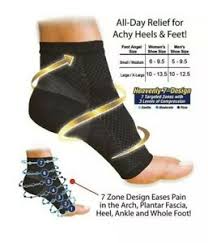
What we deduce from the images provided by doc socks, the seven areas include:
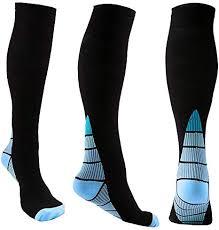
- Back of the ankle
- Upper heel
- Lower heel
- Mid-underfoot
- Front underfoot
- Top of the foot
- Front of ankle
- And the whole plantar fascia area
According to Doc Socks, each of the areas listed plays a vital role in mobility and bears weight when walking, sitting or standing. Therefore, compression in these areas will promote foot health through increased blood circulation and reduce pain through added support.
Podiatrist Designed
While Doc Socks claims that their products were designed by a podiatrist, there’s no evidence to prove this or even the name of the foot doctor who recommends this product. We find that to be curious and it makes us ask more questions.
Cures Plantar Fasciitis
Doc Socks claims that their product can prevent plantar fasciitis (a painful condition that pops up where connective tissue attaches to the heel). According to science, the best way to alleviate this condition is resting and pain medication. Based on this, it is our understanding that compression socks cannot cure plantar fasciitis, but rather pain medication and rest will be best suited to treat this condition.
As far as prevention is concerned, the best way to keep the plantar fascia at bay is by using shoe inserts and heel cups, thus promoting healthy arches and reducing stress on the plantar fascia. Other factors include wearing properly fitting shoes, doing daily calf stretches and running on flat surfaces to prevent this condition.
One Size Fits All
Because Doc Socks claims to have a universal fit, they say you do not have to worry about getting the right size. They are said to stretch and conform to the shape of your feet. But we know from experience that this is simply impossible. In order to get high-quality, effective compression socks, it is necessary to fit them to the size and compression strength that your doctor suggests. One size simply cannot fit all.
Doc Socks Reviews: A Summary
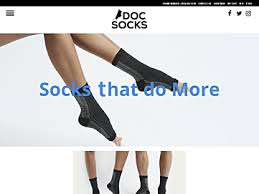
Although this brand has been surrounded by a lot of hype, Doc Socks has also gone through a certain amount of scrutiny, with many buyers summing up their experiences online. These reviews are mostly mixed as one user claims to benefit from the socks while another claims it did more harm than good.
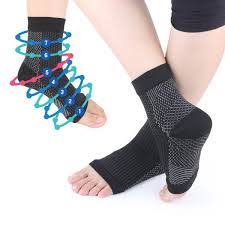
We have gone through a lot of research regarding Doc Socks, including the socks’ manufacturers. We have also read through other sock reviews provided by other professional publishers and customers.
In looking at the reviews, we find that people like Doc Socks for a few reasons such as durability, breathability, and fashion. However, other reviews lead us to question their legitimacy.
For instance, one review of Doc Socks claimed that they help with diabetes. (Diabetes is a condition which is associated with blood sugar level.) The review claimed that the socks help with blood sugar levels by maintaining an enhanced sugar in blood circulation. But that just doesn’t add up to good science or medicine. We love compression socks, but they have their limits and they certainly aren’t a magical cure-all.
So we can know to discount these types of reviews.
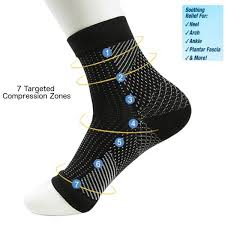
Many people in reviews mention the fact that they love the One-Size-Fits-All technology that Doc Socks offers. The convenience of one-size-fits-all may work if you’re an average person needing an average amount of sock pressure but, otherwise, the concept simply breaks down. In fact, after going through reviews online, we discovered that there are many complaints about these socks not fitting properly, which is very interesting considering the company’s claims of a universal fit.
Some reviewers like the fact that Doc Socks offers trendy designs. But the good news is that other companies also provide this feature (ComproGear has these sassy striped socks, for instance).
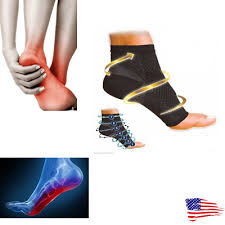
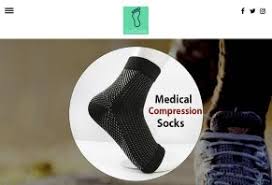
Many Doc Sock reviews hype up the fact that their socks can be worn all day long with comfort. But that’s actually what wearers of compression socks are supposed to do–wear them all day long from morning until night. That makes them no different than any other reputable compression sock. And when they are properly fitted to you personally (size and pressure), then you’ll know you can be comfortable in them all day long.
Unfortunate Doc Hoses Experiences
Many customers have made complaints about being not being able to fit the socks in their feet, which is ironic considering the company’s claim that one size will fit all.
But one size simply cannot fit all. And the idea that is can (whether in socks or shirts or rain jackets) is just rather silly, especially when you’re talking about a product that is meant to provide compression to the feet, ankles and legs.
The viral popularity of Doc Socks has caused us to wonder if the positive reviews they have received are even legitimate. But what probably is legitimate is the significant number of complaints lodged by people against the company, found on file with the Better Business Bureau, for unfair business practices and even accusations of credit card fraud. This certainly gives a consumer reason to pause.
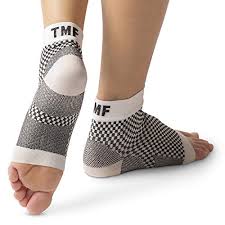
One other concern that consumers should make note of is that Doc Socks are not actually available on all of the standard, reputable e-commerce platforms (such as Amazon). As these platforms tend to enforce safety and regulatory practices, it’s hard for a product with sketchy claims (like Doc Socks) to get themselves sold here.
| Medical Hosiery are Suitable for: | Doc-Socks are Suitable for: |
| Varicose Veins Spider Veins Deep Vein Thrombosis and Edema to mention a few | Plantar Fasciitis Achilles Tendinitis Diabetic Neuropathy |
Conclusion

The final verdict on Doc Socks review is that a wise consumer will approach the company with a deep amount of caution. One-Size-Fits-All is a non-scientific marketing ploy, which means the product does not live up to its claims. Plus, aside from the ineffectiveness of the products, the company seems to have some questionable business practices.
All of this probably seems like bad news, but don’t worry! Doc Socks isn’t the only company to offer compression socks. In fact, many reputable companies have been out there providing high-quality, scam-free socks for many years!
If you prefer to have a professional fit them for you the first time, check with your local pharmacy. But don’t forget, ComproGear is thrilled to be able to provide you with easy, online access to fashionable and healthy compression socks that can be conveniently delivered right to your home. You certainly won’t regret it!
